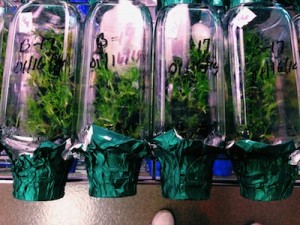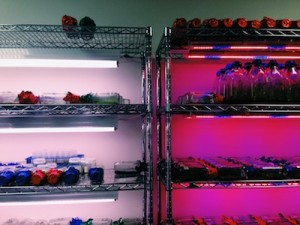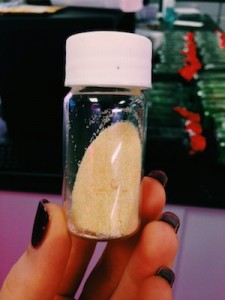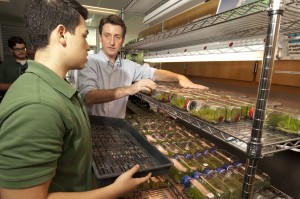Posted May 5, 2014
By PHOEBE FITZ
Once a natural orchid paradise, South Florida has all but lost the exotic-looking plants that once filled the Miami springtime with beauty and fragrance.
Fairchild Tropical Botanic Garden, a non-profit organization dedicated to showcasing and conserving Florida’s tropical plants, is stepping in to help by launching the Million Orchid Project. Their goal: to reintroduce one million endangered Florida orchids throughout Miami and its surrounding neighborhoods within five years.
The Million Orchid Project uses micropropagation techniques, or laboratory plant cloning, to generate new populations of two native orchids: the butterfly orchid and cowhorn orchid. The two species will grow in the lab until they reach three years of age, when they will be planted throughout Miami’s cityscape.
“Our goal is to reintroduce a million,” said Brooke LeMaire of the garden’s marketing department, “we have an agreement with the City of Coral Gables to install 250,000 orchids throughout it; around Miracle Mile, the Village of Merrick Park—wherever city officials ask for them to be planted.”
The city is donating $30,000 a year for the next five years to the project.
Fairchild’s micropropagation laboratory opened in December 2012 as part of the garden’s DiMare Science Village. There, volunteers with diverse career backgrounds in science donate their time working in the lab.

Orchid seedlings begin their life cycle in bottles kept in Fairchild’s state of the art micropropagation lab, which opened in 2012 as part of their DiMare Science Village (Photo by Phoebe Fitz).
The volunteers first create a base out of gel, agar and banana powder. Then, to avoid contamination, they sterilize the seedpods that can contain up to 12,000 seeds each and place them in the base. After a few months, the sprouted seeds are painstakingly moved by hand to larger containers.
Later on, the orchid seedlings are moved to an offsite nursery at the Center for Tropical Plant Conservation. There, they are placed in mulch-filled baskets until they’re mature enough to grow on trees. This quality—non-parasitic growth on other plants—is what makes the butterfly and cowhorn orchids epiphytic, versus their terrestrial counterparts.
Their epiphytic nature is one of the reasons their populations are struggling so much, as it makes reproducing naturally difficult.
“They have to land on a very specific part of a tree that has on it a very specific kind of fungus,” said LeMaire. “With the condition they’re in now number wise, they can’t do that very well.”
Their epiphytic nature is also what makes this urban-centered restoration project possible.

An experiment testing whether natural or space-age lighting will affect the orchids growth takes place in the garden’s micropropagation lab (Photo by Phoebe Fitz).
“What’s unique about epiphytic orchids is you don’t need a natural forest to grow them,” explained Dr. Hong Liu, a professor at FIU and lead researcher on the project. “As long as you have one tree, you can have your orchids.”
The Million Orchid Project is modeled largely off a similar experiment done in Singapore by the Singapore Botanic Gardens.
Their results indicated that orchids grow just as well in cities as they do in natural areas, which is what motivated Dr. Liu along with Fairchild’s director, Dr. Carl Lewis, to bring the project to Miami.
Singapore had overharvested their orchids much like South Florida has, but for different reasons. Instead of cultivating orchids for their aesthetic value, they were utilizing them for medicinal purposes—a tradition in many Asian cultures including China, whose people account for almost 75% of Singapore’s population.
“In Chinese culture, orchids have been used as medicine for thousands of years,” said Dr. Liu. “China has around 1,800 species of orchid, and about 20 percent of them are used for various medicinal purposes.”

The orchids resemble dust particles at the earliest stage of their lives, and the seedlings must be painstakingly transferred by hand to and from different containers to continue their growth (Photo by Phoebe Fitz).
Aside from Singapore Botanical Garden’s project, there have been no other experiments reintroducing plants to cityscapes over rural areas—which is what makes the project so unique.
“This project has been done before with other plants in other cities, in which they planted in natural areas like parks and gardens. What makes our project unique is we want to reintroduce the orchids to a cityscape,” LeMaire said.
Not only is the Million Orchid Project aesthetically improving the community and helping conservation efforts, it is also educating and inspiring schoolchildren.
In October 2013, Fairchild brought 10,000 orchid seedlings to TERRA Environmental Research Institute, a magnet school in Miami-Dade County.
TERRA students did an experiment of their own; testing whether the amount of light the orchids received would affect their growth. Some of the plants were given twelve hours of light a day, while others were given sixteen.

Fairchild volunteers help TERRA Environmental Research Institute students who are experimenting whether or not the amount of light exposure orchids receive relates to their growth (Photo courtesy of Fairchild Tropical Botanic Garden).
Getting local students involved is part of the reason Dr. Liu sees the project as having so much potential.
“Urban-centered restoration is a wonderful platform for public education”, she said, “citizens will see the flowerings, schoolchildren can participate—it’s a good compliment to what we’re doing in the wild to restore natural populations.”
On Earth Day, Fairchild volunteers planted the first batch of orchids in Merrick Park.
“Today, Earth Day in Coral Gables, is the moment when we reverse the decline in our native orchids,” said Dr. Lewis at the opening ceremony. “Over the next five years, we’ll start to see the first flowerings.”
Fairchild’s Million Orchid Project is leading us to a brighter tomorrow. For more information, please visit www.fairchildgarden.org.
